Uncle Sam and
The World's Columbian Exposition

Uncle Sam and Columbia Host the 1893
Chicago World's Fair
By Doug Boilesen 2022
Uncle Sam and Columbia were symbols
and hosts representing the United States at the World's Columbian
Exposition in Chicago, 1893.
The following are some of the products
that Uncle Sam promoted as seen in their respective 1893 World's
Fair trade cards. This promotional role by Uncle Sam circa 1893
also shows his growing presence in politics, commerce and popular
culture.
Trade card for Re:Marks Solid Comfort
Trade card for F&W Co., Stoves
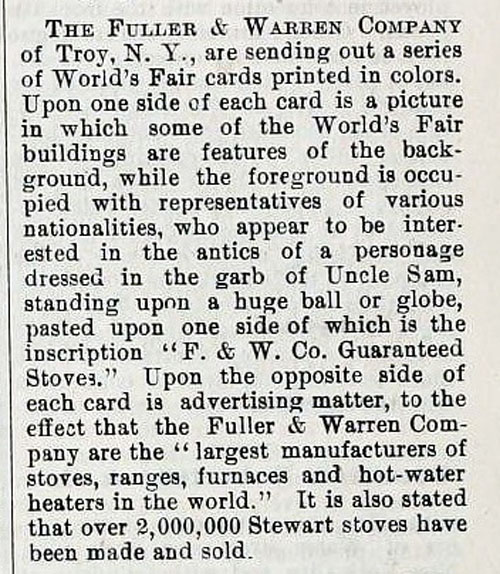
"Uncle Sam, standing
upon a huge ball or globe advertising for F & W. Co. Guaranteed
Stoves," The Metal Worker, August 5, 1893 (Courtesy of
Allen Koenigsberg)
Uncle Sam Promoting
Hub Gore, Makers of Elastic for Shoes
Of all the trade cards
that have an association with the 1893 Exposition and Uncle Sam,
the Hub Gore cards are obviously the most interesting to Friends
of the Phonograph since there actually was an exhibit at the
fair which did feature an effigy of Uncle Sam "speaking"
his Hub Gore sales message by means of an Edison Phonograph. For
that story and related details see the Antique Phonograph's
“Rest
about 10 seconds between speeches.” The Uncle Sam Mystery
at the 1893 World’s Fair by Allen Koenigsberg, March 2023.
There are currently four
Hub Gore trade cards showing Uncle Sam promoting Hub Gore shoes
at the 1893 Columbian Exposition (none of which was released during
the Exposition). All of those trade cards are basically the same
colored lithograph with the exception of the last version using
white lettering in its red heart trade-mark.

This Beacon Lith Co. Boston trade
card showing Uncle Sam promoting Hub Gore shoes at the 1893 Columbian
Exposition with the automaton using an Edison Phonograph to "talk"
is the earliest of the four Hub Gore trade cards (Beacon Lith Co.
Boston, March,1894) (PM-0650). As noted in Koenigberg's "The
Uncle Sam Mystery at the 1893 World's Fair" this date is established
by the announcement in the one-time Exposition Issue of the
trade journal Boot and Leather Reporter (March 1, 1894) that
this "superbly colored" lithographed card is "now
being supplied to all manufacturers who put them in their cartons."
Ibid.
The other three cards include the
Armstrong & Co. Lith. Boston (below); the unidentified lithograph
company (which also used black lettering for the "Hub Gore
A" red heart trade mark); and the Armstrong, Moore Co. Boston
lithographed card which used white lettering for the "Hub Gore
A" red trade mark.
Hub Gore Trade Card "
(Armstrong & Co. Lith. Boston)
Trade card with no
lithographer company identified.
This trade card (Armstrong,
Moore Co. Boston) used white lettering for the "Hub Gore A"
red Trademark and is the last version issued.

Trade card for Berry
Bros. Hard Oil Finish (Henry Seibert & Bro. N.Y., 1893. (The
National Museum of American History)

An advertisement by James
B. Campbell for the World’s Columbian Exposition, Chicago, 1893. (Chicago
History Museum)


Trade card for The Everett
Piano, The John Church Co., ©1892.

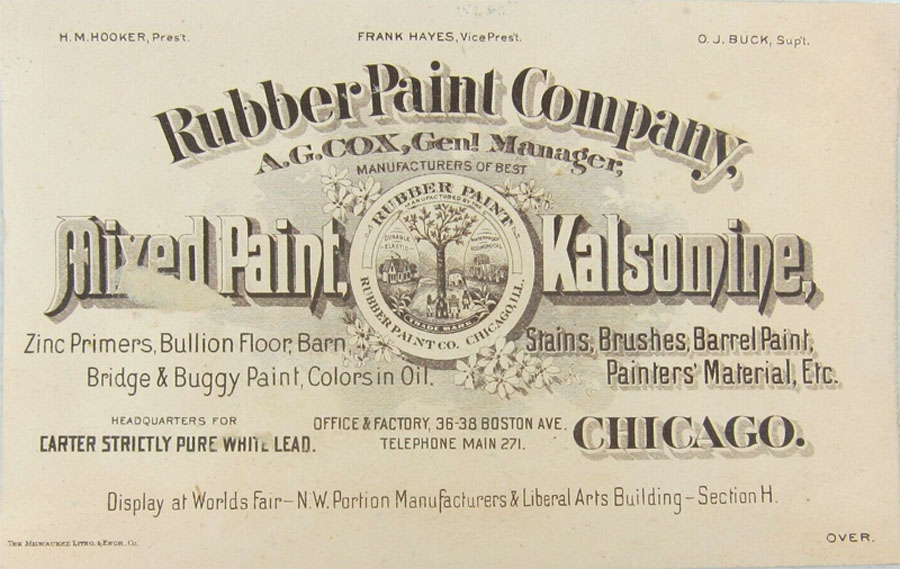
Trade card for Rubber
Paint Company, The Milwaukee Litho & Ewor., Co.
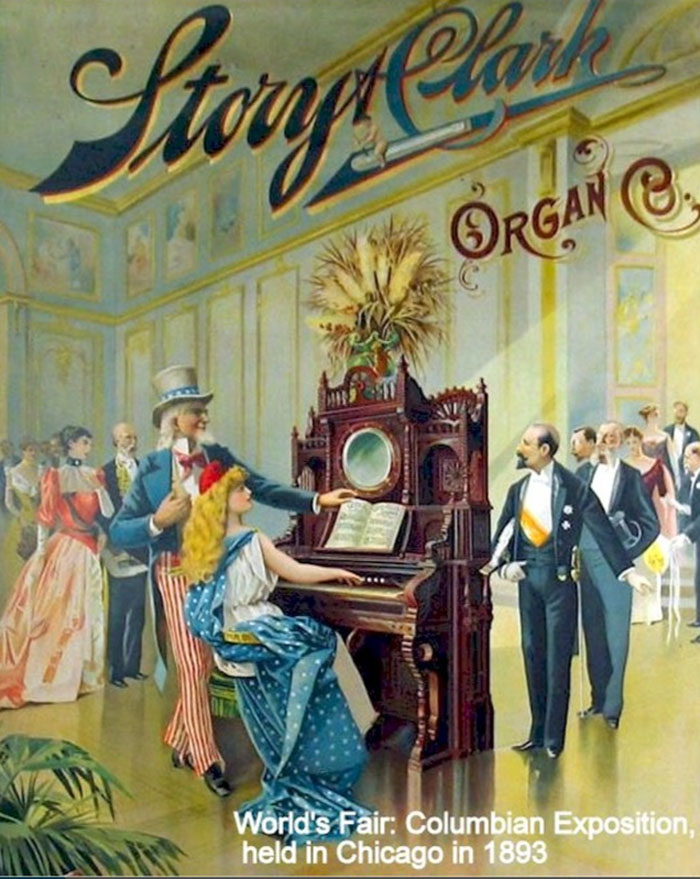
Story & Clark Organ
Co., 1893 Columbian Exposition ad (Flickr)
Uncle Sam Turning the Crank
This Enterprise Meat Chopper being
cranked by Uncle Sam is the multiple degrees of separation endpoint
of a 'string' connecting
Uncle Sam turning the crank and promoting Enterprise's Meat Chopper
in 1893 and the string's other endpoint being Brother Jonathan/Uncle
Sam turning the crank of Edison's Tinfoil Phonograph and promoting
the Enterprise's
Mrs. Potts' Sad Iron in an 1878 ad in Frank Leslie's
Illustrated Newspaper.
In the above Meat Choppers trade card
Uncle Sam is standing next to Lady Liberty and the American Eagle.
Exposition buildings are partially seen in this card and are also
part of other Enterprise trade cards for this World's Fair. The
copyright on the trade card is 1893 and was likely distributed before
the fair closed on October 30, 1893. It was common, however, for
companies after the fair to create trade cards to highlight their
World's Fair 'awards' and their association with having been at
the fair.
(See The
Enterprise Company WCE Trade Cards collection for what I
think is the most interesting series of trade cards made for the
1893 World's Fair).

Back of trade card for
Enterprise Meat Choppers, Donaldson Brothers Litho, ©1893
Miss Columbia
at the World's Columbian Exposition of 1893

1893 Worlds Fair
Columbian Exposition Souvenir Die Cut Needle Case with Miss Columbia
Uncle Sam as seen in Puck,
The Inter Ocean Illustrated Supplement, and sheet music, each
with connections to the World's Columbian Exposition of 1893.

Uncle Sam awarding 1892
World's Fair to New York, Puck, 1889 by J. Keppler


World's Fair Puck
"Grand Finale of the Stupendous Spectacular Success, Uncle
Sam's Show." by Frederick Burr Opper
Puck, 1893 Oct.
30, p. 314. - Copyright by Keppler & Schwarzmann.
"Caricature of Uncle
Sam dancing with eight men, stereotypically representing other Nations,
at end of the Chicago World's Fair." (Courtesy Library of Congress).
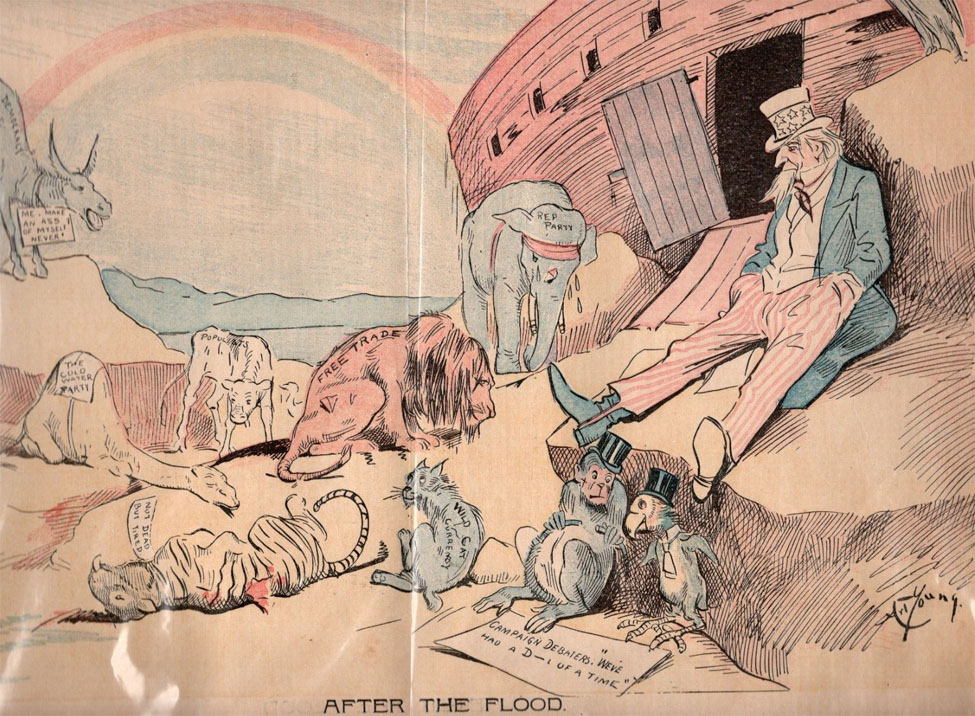
"AFTER THE FLOOD"
by Arthur Young
'NOAH UNCLE SAM "This
Much Is Sartin, Them Animals Got A Terrible Shakin' Up"'
The Inter Ocean Illustrated
Supplement, 1893
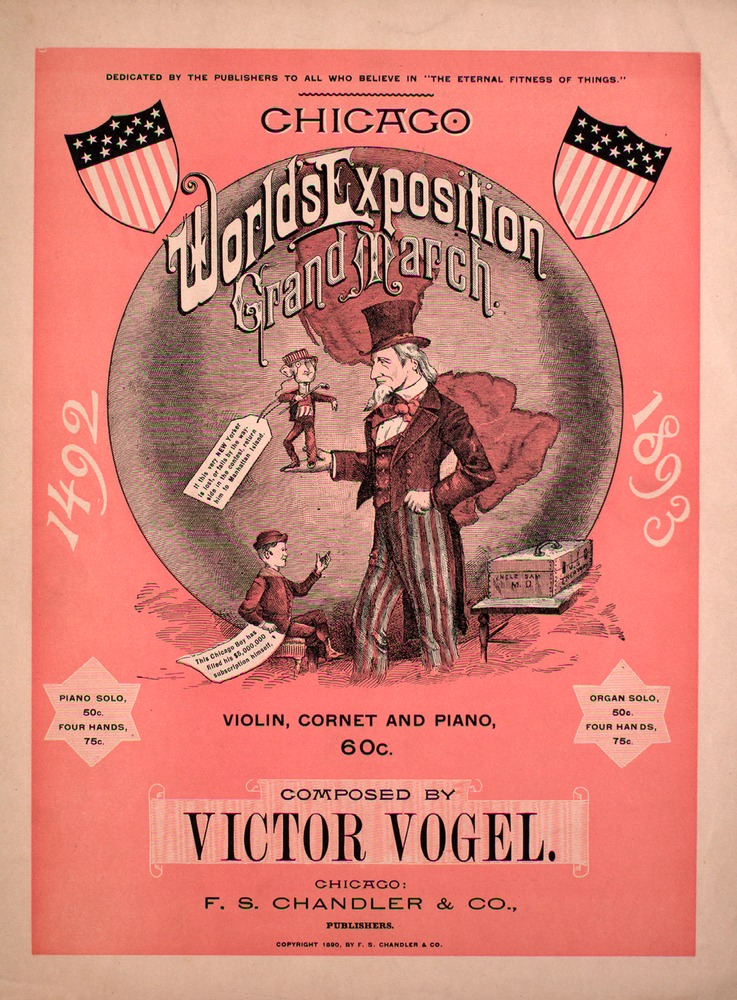

Uncle Sam making American products and
taking sales orders from the world (including the phonograph), Judge,
1899.
Edison Advertising Form
392, circa 1901 (PM-1347)

Phonographia
|

























